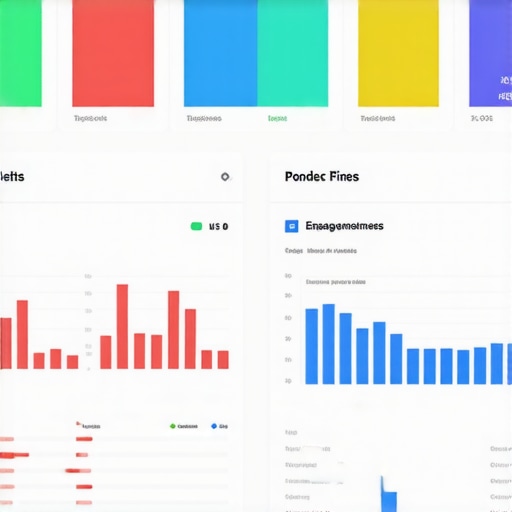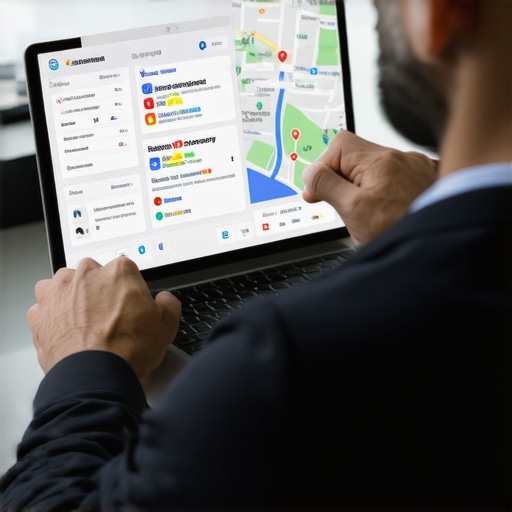How I Faced My First Google Business Profile Ranking Crisis
It all started when I noticed my Google Business Profile (GBP) suddenly lost its position in local search results. As someone who relies heavily on local SEO for my small business, this was a wake-up call. I remember feeling frustrated and a bit helpless, thinking I might have lost my visibility forever. But I knew I had to act quickly.
Understanding the Root Causes of Ranking Problems
Through my experience, I discovered that ranking issues often stem from several factors: spammy edits, inconsistent NAP (Name, Address, Phone number) data, or even Google algorithm updates. I came across an insightful guide from GMB Exorcist, which helped me understand that identifying the precise cause is crucial before attempting recovery.
My Personal Strategy for Profile Recovery
First, I audited all my profile information and ensured consistency across all online platforms. Next, I addressed any spam or suspicious activity by applying spam fix techniques. I also reached out to Google support and submitted a request for review, explaining my situation honestly. Patience was key, but I was determined to follow through with proven strategies.
What Are the Common Mistakes That Can Worsen Your Ranking?
Have I Been Overlooking Critical Profile Details?
Many business owners, myself included initially, underestimate how vital complete and accurate profile information is. Incomplete profiles can mislead Google and hurt your ranking. Ensuring your profile complies with Google’s guidelines and fixing any inconsistencies can make a huge difference. For more detailed insights, I recommend exploring top profile recovery tips.
If you’re struggling with similar issues, don’t hesitate to share your experiences or ask questions below. Sometimes, community insights can provide fresh perspectives that accelerate recovery.
What Are the Hidden Factors That Undermine Your GBP Rankings?
While most business owners focus on visible profile elements, many overlook the subtle yet impactful factors that can sabotage their rankings. For example, inconsistent keyword usage across your profile and website can confuse Google’s algorithms, making it harder to rank locally. Additionally, neglecting frequent profile updates or ignoring negative reviews can send mixed signals to Google, reducing your credibility and visibility. Understanding these nuances requires a deep dive into your overall online reputation and activity patterns. For advanced insights, check out top profile recovery tips.
How Can I Leverage External Citations to Boost My Profile’s Authority?
External citations from reputable sources act as trust signals for Google, reaffirming your business’s legitimacy. Building consistent citations across industry directories, review sites, and local news outlets enhances your profile’s authority. This, in turn, can lead to improved rankings, especially if your citations include accurate NAP data and relevant keywords. Incorporating these strategies requires a meticulous approach—monitoring citation consistency and avoiding duplicate listings. For practical implementation, explore effective ranking solutions.
Are You Addressing the Core Technical SEO Elements for Local Rankings?
Technical SEO isn’t just for websites; it extends to your Google Business Profile as well. Ensuring your profile adheres to Google’s technical requirements—like proper categorization, accurate contact info, and optimized images—can significantly influence your ranking. For example, high-quality photos with geotags can improve local visibility, while verifying your profile via multiple methods adds layers of trust. Regular audits aimed at technical compliance can prevent ranking drops caused by algorithm updates or spam filters. To master these aspects, visit profile recovery techniques.

Optimized profile with consistent NAP data, relevant keywords, and high-quality images enhances local SEO.
What Practical Steps Can You Take Today to Reclaim Your GBP Rankings?
Start by conducting a comprehensive profile audit—verify all information, update photos, and respond to reviews. Next, implement spam removal techniques to eliminate malicious edits that could harm your profile’s credibility. Reach out to Google support if necessary, and submit a detailed review request. Also, actively build external citations and engage with your community through local content and events. These steps, combined with ongoing monitoring, can accelerate your recovery process. For more expert tips, visit top ranking solutions.
Unveiling the Subtle Interplay Between Content Quality and Algorithm Perception
As I navigated the complex landscape of GBP recovery, I realized that beyond technical fixes, the content I showcased played a pivotal role in shaping Google’s perception. High-quality, relevant, and regularly updated content signals to Google that your profile is active and authoritative. For instance, sharing behind-the-scenes updates or community involvement not only humanizes your brand but also fosters engagement, which Google favors in local rankings. I once experimented with adding local news or event posts, which surprisingly gave my profile a fresh boost. This underscores how nuanced content strategies, aligned with your audience’s interests, can subtly but effectively influence rankings.
How Do I Balance Immediate Fixes with Long-term SEO Health?
In my experience, quick fixes—like spam removal or profile verification—are essential but insufficient if not paired with long-term strategies. The real challenge lies in maintaining consistency: updating your profile with new photos, responding to reviews authentically, and monitoring citation accuracy. I adopted a bi-weekly review schedule, which helped me stay ahead of potential issues before they escalated. This proactive approach ensures that your GBP remains resilient against algorithm shifts and competitive pressures. For deeper insights into sustainable practices, I recommend exploring top strategies for profile recovery.
Deciphering the Complex Interplay Between Profile Signals and Algorithmic Perception
Through my extensive experience navigating GBP challenges, I realized that the subtle cues within your profile can profoundly influence Google’s perception. Beyond the surface-level fixes, understanding how intricate signals—like semantic keyword variations, schema markup integration, and behavioral engagement metrics—interact can elevate your profile’s authority. For instance, implementing microdata snippets that highlight your business categories can enhance relevance, tapping into Google’s nuanced understanding of your niche. Additionally, analyzing user engagement patterns, such as click-through rates and review sentiment shifts, provides invaluable insights into how your profile resonates with audiences and algorithms alike. For a deeper dive into these sophisticated techniques, I recommend exploring authoritative resources like Moz’s in-depth guide.
Balancing Immediate Corrections with Strategic Long-term SEO Resilience
My journey underscored the importance of not just quick fixes but cultivating a resilient SEO ecosystem. Immediate actions—such as spam removal, profile verification, and review responses—address urgent issues. However, embedding these within a broader strategic framework—like creating authoritative local content, fostering community relationships, and building diversified citation profiles—ensures sustainable growth. I adopted a layered approach: weekly audits for technical compliance, monthly content updates sharing community stories, and quarterly citation audits to prevent duplicates. This holistic methodology shields my GBP from volatile algorithm shifts and competitive threats. To strengthen your long-term resilience, I highly recommend exploring Neil Patel’s comprehensive local SEO strategies.
What Advanced Techniques Can Help You Leverage Data-Driven Insights for GBP Optimization?
Utilizing analytics tools like Google Insights and third-party reputation management platforms enables you to monitor detailed engagement metrics, review sentiment trajectories, and competitor benchmarking. By dissecting this data, I discovered patterns—such as peak activity times and review themes—that informed my content scheduling and review solicitation strategies. Incorporating A/B testing for profile updates and monitoring their impact on rankings can reveal what resonates best with your local audience. These advanced insights, coupled with a consistent review of your citation health and keyword relevance, create a feedback loop that continually refines your profile’s performance. For practical guidance, I suggest reviewing top tips for data-driven GBP optimization.

Analyzing engagement analytics dashboard displaying local search trends and review sentiment shifts.
Things I Wish I Knew Earlier (or You Might Find Surprising)
The Power of Consistency
One thing that caught me off guard was how crucial consistent information and activity are for GBP rankings. Initially, I thought fixing a few errors would suffice, but I soon realized that regular updates, review interactions, and citation management have a compounding effect on visibility.
Beyond Technical Fixes
I used to focus mainly on technical issues like verification and spam removal, but I discovered that content quality and engagement matter just as much. Sharing local stories or community involvement can give your profile a genuine boost, making it more appealing to both Google and potential customers.
The Subtle Art of External Citations
Building external citations sounds simple, but I underestimated how much their quality and consistency influence rankings. Reputable sources and avoiding duplicate listings became a game-changer once I paid attention to them, reinforcing my profile’s authority.
Technical SEO Isn’t Just for Websites
Optimizing images, proper categorization, and schema markup for your GBP can significantly impact local search results. I learned that paying attention to these details can prevent ranking drops and enhance your local visibility, especially during algorithm updates.
Data-Driven Decisions Make the Difference
Monitoring engagement metrics like click-through rates and review sentiment helped me understand what strategies worked best. Using analytics tools to refine my approach turned out to be one of the most effective long-term solutions I found.
Resources I’ve Come to Trust Over Time
- Moz’s Local SEO Guide: This comprehensive resource deepened my understanding of how local signals influence rankings and taught me practical optimization techniques.
- Neil Patel’s Blog: Neil’s insights into SEO strategies are always practical and easy to implement, making complex concepts accessible.
- Google’s Official Business Profile Help Center: The official documentation provided clarity on technical requirements and best practices directly from Google.
Parting Thoughts from My Perspective
If you’re dealing with a ranking crisis on your Google Business Profile, remember that recovery isn’t just about quick fixes; it’s about building a resilient, well-maintained profile over time. Consistency, quality content, authoritative citations, and technical accuracy are your best allies. Don’t get discouraged by setbacks—view them as opportunities to refine your strategy and deepen your understanding of local SEO. If this resonated with you, I’d love to hear your thoughts or experiences. Feel free to share or ask questions below. Your journey to a thriving GBP is worth it, and every step forward counts!

Reading your detailed experience with recovering a Google Business Profile really resonated with me. I recently faced a similar challenge when my GBP rankings plummeted after an algorithm update, and the approach of auditing all profile information and fixing inconsistencies was exactly what I needed to hear. I’ve found that maintaining detailed records of profile changes and continually updating relevant content helps improve engagement and rankings over time. The part about leveraging external citations is a game-changer—building quality links across reputable directories really boosts authority. I wonder, for those who have been through this, what tools or processes do you recommend for efficiently tracking citation consistency and reviews across multiple platforms? I’ve been thinking about using some reputation management tools but would love suggestions on which ones are most effective. It’s clear that balancing technical fixes with ongoing content and reputation management yields the best long-term results. Looking forward to hearing others’ experiences and tips on sustaining GBP health in the face of ongoing updates.
Your detailed recount of facing and recovering from GBP ranking issues truly highlights how critical consistency and technical accuracy are for local SEO. I’ve experienced similar frustrations when my profile suddenly dropped in rankings, and I found that regularly auditing NAP data and keeping profile information up-to-date made a big difference. The emphasis on external citations resonates with me—I’ve seen tangible improvements by building authoritative links and ensuring their accuracy across platforms.
I’m curious, for those managing multiple listings or citations, what tools or workflows have you found most effective for tracking and maintaining citation consistency? I’ve been experimenting with reputation management software but would love to hear about any favorites that simplify this process. Additionally, I think the community could benefit from sharing strategies on how to balance quick technical fixes with ongoing content updates and engagement efforts. Has anyone had success with content scheduling or review response routines that keep GBP healthy long-term? Looking forward to hearing more insights and real-world tactics from fellow local SEO practitioners!